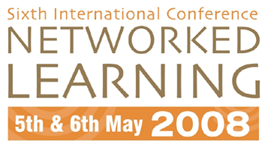

Helping Educators Analyse Interactions within Networked Learning Communities: A Framework and the AnalyticsTool System
Ourania Petropoulou, Symeon Retalis, Konstantinos Siassiakos
University of Piraeus, Department of Technology Education and Digital
Systems, GREECE rpetro@biomed.ntua.gr, retal@unipi.gr, siassiakos_k@ideke.gr
Stamos Karamouzis,
Regis University, School of Computer & Information Sciences, USA skaramou@regis.edu
Theodoros Kargidis
Technological Institute of Thessaloniki, Department of Marketing, GREECE
kargidis@mkt.teithe.gr
Abstract
In the era of networked learning, the “network” component plays an important role in the formation of learning communities – the networked learning communities (NLC) – since it promotes and facilitates collaborative and co-operative connections: between one learner and other learners; between learners and tutors; between learners and learning resources, so that learners and tutors can extend and develop their understanding and capabilities in ways that are important to them, and over which they have significant control.
In a NLC, where individual and collective actions take place, educators face great difficulties in evaluating the broad spectrum of interactions among the interacted participants (student-student, student-educator, student-learning resources) during learning processes. It becomes difficult and time consuming for educators to thoroughly capture, track and assess the various interactive learning activities performed by all learners. The need for designing specific tools, which will be based on well-grounded conceptual frameworks, for analysing the grid of all these interactions is emerged as the issue of evaluation tends to be multifaceted and complex for educators.
Our paper proposes such a framework and identifies specific indicators that can help educators’ analyse and evaluate multiple dimensions of interactivity that is developed in a NLC. In this paper, we also present the Analyticstool, a system for the automatic analysis and visualization of data collected during the networked collaborative learning process. This tool is expected to be useful for educators who need to assess the individuals’ contributions in a NLC. AnalyticsT??l is an interaction analysis tool that automatically gathers, analyzes and visualizes data related to participants’ asynchronous interaction in a NLC.
The innovative feature of AnalyticsTool is that it can be used to analyse data of asynchronous networked learning interactions that occurred within the Moodle learning management system (LMS) which is the most popular open source LMS. A teacher, using Analyticstool, can import data from the various fora that had been used for supporting the learners’ tasks within a course into the tool, which will, then, be organized and structured in such manner that can be analyzed at various levels. The analyzed data can also be exported in appropriate formats so that it can be used as input to the SPSS statistical package or other tools such as the NetDraw software for further analysis. Another innovative feature of Analyticstool is that it guides the teacher in performing specific analysis of the data collected according to the teaching strategy followed in his/her course. For example, if a teacher uses the Think Pair Share (TPS) learning strategy in a course, AnalyticsTool will automatically create the most appropriate statistical tables and diagrams indicators for this strategy, which will be related to the quantity and quality of participation and collaboration among learners.
| About NLC |
2008 Conference Papers
| Conference Committee| Keynote
Speakers
| Papers from previous NL conferences |Research Seminars| Current Conference
| Sponsors | Contact
|
